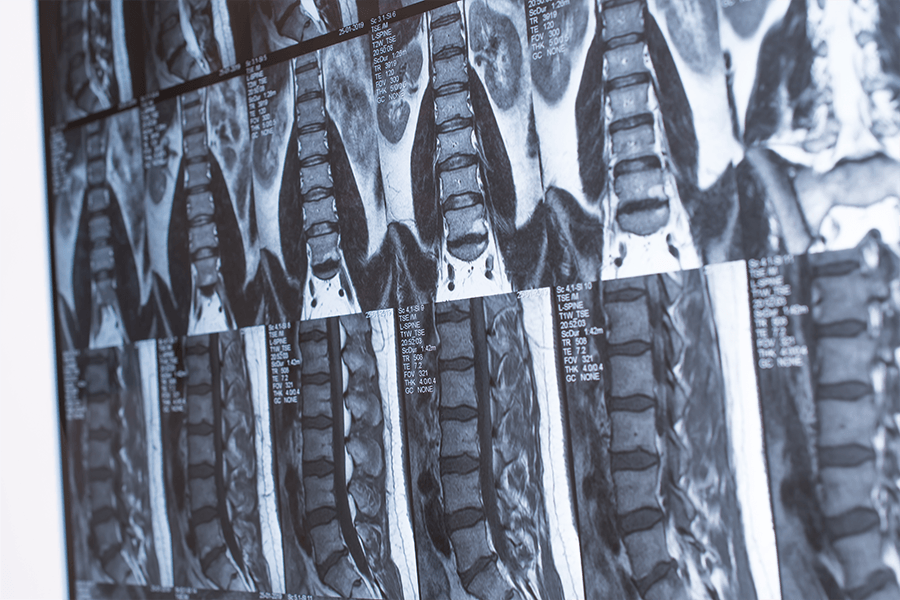General Overview
A lumbar microdiscectomy is a safe and effective operation typically performed by spine surgeons to address complaints of leg pain and/or weakness/numbness1.
The surgery is intended to relieve pressure on a spinal nerve root by removing a herniated disc. These procedures can be done through a minimally invasive approach and patients are often sent home the same day of surgery.
Who is a candidate for Microdiscectomy Surgery?
The intervertebral disc is made up of cartilage and acts like a cushion between the vertebrae, or spinal bones.
As the disc material degenerates, a crack can develop in the outer wall of the disc allowing the contents to escape, leading to a herniated disc. When a herniated disc develops in the lower back, or lumbar spine, the disc fragment puts pressure on a spinal nerve root leading to sciatica or a pinched nerve. Since the spinal cord does not pass through the lumbar spine, a herniated disc in this region of the spine will only irritate the spinal nerve roots.
A herniated disc in the lower back narrows the spinal nerve root channel and can lead to a variety of symptoms including:
-
Low back pain
-
Leg pain
-
Leg numbness and/or weakness
-
Bowel/bladder compromise – only in severe cases
When there is no weakness or numbness, appropriate medical advice is to pursue conservative care prior to surgery.
A combination of physical therapy, medications, and possible spinal injections may be considered especially if low back pain is the main complaint. A reasonable course of conservative treatment lasts approximately 6 to 12 weeks2. During this time, the treating physician should be checking to see how the patient is responding or if there is any suggestion of numbness or weakness.

A patient may be considered a candidate for microdiscectomy surgery for the following reasons:
-
The patient is unable to tolerate pain during a course of conservative care despite aggressive pain medication
-
Relief cannot be obtained after 6-12 weeks of conservative treatment
-
A patient presents with leg numbness or weakness.
Surgery should be considered much sooner if the numbness and/or weakness is severe or getting worse over time.
How is a Lumbar Microdiscectomy performed?
A Microdiscectomy can be performed through a minimally invasive approach3.
Minimally invasive spine surgery provides the benefit of less soft tissue and muscle injury leading to less post-operative pain.
These procedures are usually performed on an outpatient basis, patient may be discharged home on the same day as surgery, and allows a patient to return to work and their normal activities sooner than traditional surgery.
The operation is typically performed under general anesthesia with the patient positioned on their stomach. The location of the skin incision is made with the use of X-rays. A small incision is made in the lower back. Small tubes are passed through the muscle, instead of cutting the muscle, and placed on the spine. A small window of bone is removed to access the nerve channel. The spine nerve root is visualized and the herniated disc is removed with special instruments, relieving the pressure and irritation on the nerve.
The incision site is closed with absorbable sutures, no stitches to remove, and a small dressing applied to the wound. After a brief period of observation, patients will usually go home the same day of surgery.
What is it like after surgery?
Following the procedure, patients will experience some low back discomfort that usually resolves after about a week.
Leg pain will usually decrease immediately after surgery; however, numbness or weakness may take longer to improve. During the recovery period, physical therapy may be considered to address leg weakness, but physical therapy directed to the back is avoided until about 1 month after the operation.
Patients are encouraged to return to normal activities, such as driving, within a week of surgery. Depending on how strenuous the patient’s job, they can usually return to work during the first month after surgery.
Summary
A microdiscectomy is a minimally invasive spine surgery intended to remove a herniated disc and relieve pressure on a spinal nerve root.
Microdiscectomy surgery is typically performed by spine surgeons to address complaints such as leg pain. Patients will usually go home the same day as surgery and can return to work and their normal activities shortly after the procedure.
- Weinstein, J.N., et al., Surgical versus nonoperative treatment for lumbar disc herniation: four-year results for the Spine Patient Outcomes Research Trial (SPORT). Spine (Phila Pa 1976), 2008. 33(25): p. 2789-800.
- Deyo, R.A. and S.K. Mirza, CLINICAL PRACTICE. Herniated Lumbar Intervertebral Disk. N Engl J Med, 2016. 374(18): p. 1763-72.
- Clark, A.J., et al., Tubular microdiscectomy: techniques, complication avoidance, and review of the literature. Neurosurg Focus, 2017. 43(2): p. E7.

About Dr. Michael G. Kaiser
Dr. Michael G. Kaiser is a nationally recognized neurosurgeon in North Jersey and is a proud member of Neurosurgeons of New Jersey, practicing out of their Ridgewood office conveniently located on East Ridgewood Avenue. Dr. Kaiser specializes in complex and minimally invasive spine surgeries.
Please call today to schedule a consultation with me.
(551) 284-3265
Request a consultation with Dr. Kaiser

